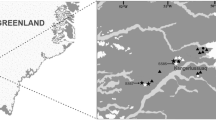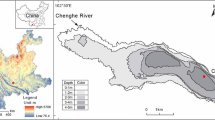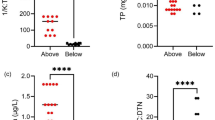Abstract
Diatom communities are composed of three distinct water-depth-associated assemblages: a nearshore benthic assemblage, a deep-water benthic assemblage, and a primarily planktonic assemblage. Light attenuation with depth has been hypothesized to be the factor that controls benthic-to-planktonic (B:P) assemblage transitions. Previous studies, however, could not distinguish between the individual effects of light and temperature on diatom assemblage transition because the depth of the B:P transition occurred at or near the depth of the thermocline. This has caused confusion regarding which factor is the more influential variable on benthic-planktonic diatom assemblage transition in surface sediments along water-depth transects in lakes. Two boreal lakes in northeast Ontario were selected to examine this problem. The study lakes are sufficiently deep and clear (Secchi disk depths ~ 9–10 m; dissolved organic carbon ~ 3 mg/L), making it possible to distinguish between the depth of 1% light penetration and the depth of the thermocline. Surface sediment samples were collected along water-depth transects from these lakes to examine intra-lake diatom assemblage structure. In both lakes, the water depth of the diatom assemblage B:P transition was closely associated with the depth of the ~ 1% photosynthetically active radiation value, and was well below the depth of the thermocline, suggesting that light penetration has more influence on this transition than does the thermocline. Because temporal fluxes in nutrients and DOC concentrations can attenuate light, understanding how the light regime influences benthic diatoms in lakes can help inform interpretations of diatom assemblage changes in paleolimnological studies.







Similar content being viewed by others
References
Agarwal S, Wills J, Cayton L, Lanckriet G, Kriegman D, Belongie S (2007) Generalized non-metric multidimensional scaling. Proc Int Conf Artif Intel Stat 2:11–18
Angeli N, Cantonati M (2005) Depth-distribution of surface sediment diatoms in Lake Tovel, Italy. Internationale Vereinigung für theoretische und angewandte Limnologie: Verhandlungen 29:539–544
Battarbee RW (1984) Diatom analysis and the acidification of lakes. Philos Trans R Soc Lon 305:451–477
Battarbee RW, Jones VJ, Flower RJ, Cameron NG, Bennion H, Carvalho L, Juggins S (2001) Diatoms. In: Smol JP, Last WM (eds) Tracking environmental change using lake sediments terrestrial, Algal and siliceous indicators, vol 3. Springer, Dordrecht, pp 155–202
Bennion H (1994) A diatom-phosphorus transfer function for shallow, eutrophic ponds in southeast England. In: Mortenson E, Jeppesen E, Søndergaard M, Kamp Nielsen L (eds) Nutrient dynamics and biological structure in shallow freshwater and Brackish Lakes. Springer, Dordrecht, pp 391–410
Bennion H, Simpson GL (2011) The use of diatom records to establish reference conditions for UK lakes subject to eutrophication. J Paleolimnol 45:469–488
Berger SA, Diehl S, Stibor H, Trommer G, Ruhenstroth M (2010) Water temperature and stratification depth independently shift cardinal events during plankton spring succession. Glob Change Biol 16:1954–1965
Blais JM, Kalff J (1995) The influence of lake morphometry on sediment focusing. Limnol Oceanogr 40:582–588
Boeff KA, Strock KE, Saros JE (2016) Evaluating planktonic diatom response to climate change across three lakes with differing morphometry. J Paleolimnol 56:33–47
Brown SD, Austin AP (1973) Diatom succession and interaction in littoral periphyton and plankton. Hydrobiologia 43:333–356
Brown RE, Nelson SJ, Saros JE (2017) Paleolimnological evidence of the consequences of recent increased dissolved organic carbon (DOC) in lakes of the northeastern USA. J Paleolimnol 57:19–35
Environment Canada (2019) Canadian Climate Normals 1981–2010 Station Data. Available at: https://climate.weather.gc.ca/climate_normals/results_1981_2010_e.html?searchType=stnName&txtStationName=Timmins&searchMethod=contains&txtCentralLatMin=0&txtCentralLatSec=0&txtCentralLongMin=0&txtCentralLongSec=0&stnID=4180&dispBack=1. Accessed September 2019
Cantonati M, Lowe RL (2014) Lake benthic algae: toward an understanding of their ecology. Freshw Sci 33:475–486
Cantonati M, Scola S, Angeli N, Guella G, Frassanito R (2009) Environmental controls of epilithic diatom depth-distribution in an oligotrophic lake characterized by marked water-level fluctuations. Eur J Phycol 44:15–29
Cantonati M, Guella G, Spitale D, Angeli N, Borsato A, Lencioni V, Filippi ML (2014) The contribution of lake benthic algae to the sediment record in a carbonate mountain lake influenced by marked natural water-level fluctuations. Freshw Sci 33:499–512
Charles DF, Binford MW, Furlong ET, Hites RA, Mitchell MJ, Norton SA, Oldfield F, Paterson MJ, Smol JP, Uutala AJ, White JR, Whitehead DR, Wise RJ (1990) Paleoecological investigation of recent lake acidification in the Adirondack Mountains, NY. J Paleolimnol 3:195–241
Clarke KR, Warwick RM (1994) Similarity-based testing for community pattern: the two-way layout with no replication. Mar Biol 118:167–176
Cumming BF, Wilson SE, Hall RI, Smol JP (1995) Diatoms from British Columbia (Canada) Lakes and Their Relationship to Salinity, Nutrients, and Other Limnological Variables. Bibl Diatomol 31:1–207
Dixit SS, Smol JP, Kingston JC, Charles DF (1992) Diatoms: powerful indicators of environmental change. Environ Sci Technol 26:22–33
Dixit SS, Dixit AS, Smol JP (2002) Diatom and chrysophyte functions and inferences of post-industrial acidification and recent recovery trends in Killarney lakes (Ontario, Canada). J Paleolimnol 27:79–96
Engstrom DR, Rose NL (2013) A whole-basin, mass-balance approach to paleolimnology. J Paleolimnol 49:333–347
Esri (2015) ArcGIS Desktop: Release 10.5. Redlands, CA: Environmental Systems Research.
Evans R (1994) Empirical evidence of the importance of sediment resuspension in lakes. Hydrobiologia 284:5–12
Evans CD, Chapman PJ, Clark JM, Monteith DT, Cresser MS (2006) Alternative explanations for rising dissolved organic carbon export from organic soils. Glob Change Biol 12:2044–2053
Flessa KW, Cutler AH, Meldahl KH (1993) Time and taphonomy: quantitative estimates of time-averaging and stratigraphic disorder in a shallow marine habitat. Paleobiology 19:266–286
Fritz SC, Juggins S, Battarbee RW, Engstrom DR (1991) Reconstruction of past changes in salinity and climate using a diatom-based transfer function. Nature 352:706–708
Glew JR (1991) Miniature gravity corer for recovering short sediment cores. J Paleolimnol 5:285–287
Glew JR, Smol JP, Last WM (2001) Sediment core collection and extrusion. In: Smol JP, Last WM (eds) Tracking environmental change using lake sediments basin analysis, coring, and chronological techniques, vol 1. Springer, Dordrecht, pp 73–105
Grimm EC (1987) CONISS: a FORTRAN 77 program for stratigraphically constrained cluster analysis by the method of incremental sum of squares. Comput Geosci 13:13–35
Grimm EC (2004) TILIA and TILIA GRAPH Computer Programs Version 2.0.2. Springfield: Illinois State Museum Research and Collections Center
Gushulak CAC, Laird KR, Bennett JR, Cumming BF (2017) Water depth is a strong driver of intra-lake diatom distributions in a small boreal lake. J Paleolimnol 58:231–241
Hall RI, Smol JP (1996) Paleolimnological assessment of long-term water-quality changes in south-central Ontario lakes affected by cottage development and acidification. Can J Fish Aquat Sci 53:1–17
Hall RI, Smol JP (1999) Diatoms as indicators of lake eutrophication. In: Stoermer EF, Smol JP (eds) The diatoms: applications for the environmental and earth sciences. Cambridge University Press, Cambridge, pp 128–168
Hammer Ø, Harper DAT (2006) Paleontological Data Analysis. Blackwell, Malden
Hammer Ø, Harper DAT, Ryan PD (2001) PAST: Palaeontological statistics software package for education and data analysis. Palaeontol Electron 4(1):9
Hansson LA (1988) Effects of competitive interactions on the biomass development of planktonic and periphytic algae in lakes. Limnol Oceanogr 33:121–128
Hansson LA (1992) Factors regulating periphytic algal biomass. Limnol Oceanogr 37:322–328
Hoagland KD, Peterson CG (1990) Effects of light and wave disturbance on vertical zonation of attached microalgae in a large reservoir. J Phycol 26:450–457
Hobbs WO, Telford RJ, Birks HJB, Saros JE, Hazewinkel RR, Perren BB, Saulnier-Talbot É, Wolfe AP (2010) Quantifying recent ecological changes in remote lakes of North America and Greenland using sediment diatom assemblages. PLoS ONE 5:1–12
Interlandi SJ, Kilham SS (2001) Limiting resources and the regulation of diversity in phytoplankton communities. Ecology 82:1270–1282
Interlandi SJ, Kilham SS, Theriot EC (1999) Responses of phytoplankton to varied resource availability in large lakes of the greater yellowstone ecosystem. Limnol Oceanogr 44:668–682
Karmakar M, Kurek J, Haig H, Cumming BF (2014) Consensus among multiple trophic levels during high-and low-water stands over the last two millennia in a northwest Ontario lake. Quat Res 81:251–259
Karmakar M, Laird KR, Cumming BF (2015) Diatom-based evidence of regional aridity during the mid-Holocene period in boreal lakes from northwest Ontario (Canada). Holocene 25:166–177
Kingsbury MV, Laird KR, Cumming BF (2012) Consistent patterns in diatom assemblages and diversity measures across water-depth gradients from eight Boreal lakes from north-western Ontario (Canada). Freshw Biol 57:1151–1165
Krammer K, Lange-Bertalot H (1986) Bacillariophyceae.1: Teil: Naviculaceae. In: Ettl H, Gärtner G, Gerloff J, Heynig H, Mollenhauer D (eds) Süßwasserflora von Mitteleuropa, Band 2/1. Gustav Fischer Verlag, Stuttgart
Krammer K, Lange-Bertalot H (1988) Bacillariophyceae. 2: Teil: Bacillariaceae, Epithmiaceae, Surirellaceae. In: Ettl H, Gärtner G, Gerloff J, Heynig H, Mollenhauer D (eds) Süßwasserflora von Mitteleuropa, Band 2/2. Gustav Fischer Verlag, Stuttgart
Krammer K, Lange-Bertalot H (1991a) Bacillariophyceae. 3: Teil: Centrales, Fragilariaceae, Eunotiaceae. In: Ettl H, Gärtner G, Gerloff J, Heynig H, Mollenhauer D (eds) Süßwasserflora von Mitteleuropa, Band 2/3. Gustav Fischer Verlag, Stuttgart
Krammer K, Lange-Bertalot H (1991b) Bacillariophyceae. 4: Teil: Achnanthaceae. In: Ettl H, Gärtner G, Gerloff J, Heynig H, Mollenhauer D (eds) Süßwasserflora von Mitteleuropa, Band 2/4. Gustav Fischer Verlag, Stuttgart
Kruskal JB (1964) Nonmetric multidimensional scaling: a numerical method. Psychometrika 29:115–129
Laird KR, Cumming BF (2008) Reconstruction of Holocene lake level from diatoms, chrysophytes and organic matter in a drainage lake from the Experimental Lakes Area (northwestern Ontario, Canada). Quat Res 69:292–305
Laird KR, Kingsbury MV, Cumming BF (2010) Diatom habitats, species diversity and water-depth inference models across surface-sediment transects in Worth Lake, northwest Ontario, Canada. J Paleolimnol 44:1009–1024
Laird KR, Kingsbury MV, Lewis CM, Cumming BF (2011) Diatom-inferred depth models in 8 Canadian boreal lakes: inferred changes in the benthic: planktonic depth boundary and implications for assessment of past droughts. Quat Sci Rev 30:1201–1217
Laird KR, Haig HA, Ma S, Kingsbury MV, Brown TA, Lewis CM, Oglesby RJ, Cumming BF (2012) Expanded spatial extent of the Medieval Climate Anomaly revealed in lake-sediment records across the boreal region in northwest Ontario. Glob Change Biol 18:2869–2881
Legendre P, Gallagher ED (2001) Ecologically meaningful transformations for ordination of species data. Oecologia 129:271–280
Levec F (2001) B.A.S.S. 2.0 User Manual. Inventory, Monitoring, and Assessment, Peterborough
Lotter AF, Bigler C (2000) Do diatoms in the Swiss Alps reflect the length of ice-cover? Aquatic Sci 62:125–141
Meyer-Jacob C, Michelutti N, Paterson AM, Cumming BF, Keller WB, Smol JP (2019) The browning and re-browning of lakes: Divergent lake-water organic carbon trends linked to acid deposition and climate change. Sci Rep 9:1–10
Monteith DT, Stoddard JL, Evans CD, de Wit HA, Forsius M, Høgåsen T, Wilander A, Skjelkvåle BA, Jeffries DS, Vuorenmaa J, Keller B, Kopácek J, Vesely J (2007) Dissolved organic carbon trends resulting from changes in atmospheric deposition chemistry. Nature 450:537–540
Moos MT, Laird KR, Cumming BF (2005) Diatom assemblages and water depth in Lake 239 (experimental lakes area, Ontario): implications for paleoclimatic studies. J Paleolimnol 34:217–227
Moos MT, Laird KR, Cumming BF (2009) Climate-related eutrophication of a small boreal lake in northwestern Ontario: a palaeolimnological perspective. Holocene 19:359–367
Morales-Marin LA, French JR, Burningham H, Battarbee RW (2018) Three-dimensional hydrodynamic and sediment transport modeling to test the sediment focusing hypothesis in upland lakes. Limnol and Oceanogr 63:156–176
Nelson ST, Rey KA (2018) Multi-proxy reassessment of the paleolimnology of Lake Bonneville (western USA) as observed in the restricted Pilot Valley sub-basin. J Quat Sci 33:177–193
Oksanen J, Guillaume-Blanchet F, Friendly M, Kindt R, Legendre P, McGlinn D, Minchin PR, O’Hara PR, Simpson GL, Solymos P, Stevens MHH, Szoecs E, Wagner H (2019) Vegan: Community Ecology Package. R package version 2.5–5. https://CRAN.R.project.org/package=vegan
Ontario Ministry of the Environment (1983) Handbook of analytical methods for environmental samples, vol 1, 2. Laboratory services branch Ontario Ministry of the Environment and Energy, Sudbury
Passy SI (2010) A distinct latitudinal gradient of diatom diversity is linked to resource supply. Ecology 91:36–41
Potapova MG, Minerovic, AD, Veselá J, Smith CR. 2020. Diatom New Taxon File at the Academy of Natural Sciences (DNTF-ANS), Philadelphia. https://dh.ansp.org/dntf. Accessed July 2020
R Core Team (2019) R: A language and environment for statistical computing. Vienna: The R Foundation. https://www.R-project.org
Rose KC, Winslow LA, Read JS, Hansen GJ (2016) Climate-induced warming of lakes can be either amplified or suppressed by trends in water clarity. Limnol Oceanogr Lett 1:44–53
Rose KC, Greb SR, Diebel M, Turner MG (2017) Annual precipitation regulates spatial and temporal drivers of lake water clarity. Ecol Appl 27:632–643
Rosenberger EE, Hampton SE, Fradkin SC, Kennedy BP (2008) Effects of shoreline development on the nearshore environment in large deep oligotrophic lakes. Freshw Biol 53:1673–1691
Roulet N, Moore TR (2006) Environmental chemistry: browning the waters. Nature 444:283–284
Roy M, Dell’Oste F, Veillette JJ, De Vernal A, Hélie JF, Parent M (2011) Insights on the events surrounding the final drainage of Lake Ojibway based on James Bay stratigraphic sequences. Quat Sci Rev 30:682–692
Roy M, Veillette JJ, Daubois V, Ménard M (2015) Late-stage phases of glacial Lake Ojibway in the central Abitibi region, eastern Canada. Geomorphology 248:14–23
Rühland KM, Priesnitz A, Smol JP (2003) Paleolimnological evidence from diatoms for recent environmental changes in 50 lakes across Canadian Arctic treeline. Arct Antarct Alp Res 35:110–123
Rühland KM, Paterson AM, Smol JP (2008) Hemispheric-scale patterns of climate-related shifts in planktonic diatoms from North American and European lakes. Glob Change Biol 14:2740–2754
Rühland KM, Paterson AM, Smol JP (2015) Lake diatom responses to warming: reviewing the evidence. J Paleolimnol 54:1–35
Salm CR, Saros JE, Martin CS, Erickson JM (2009) Patterns of seasonal phytoplankton distribution in prairie saline lakes of the northern Great Plains (USA). Saline Syst 5:1
Schindler DW, Bayley SE, Parker BR, Beaty KG, Cruikshank DR, Fee EJ, Schindler EU, Stainton MP (1996) The effects of climatic warming on the properties of boreal lakes and streams at the Experimental Lakes Area, northwestern Ontario. Limnol Oceanogr 41:1004–1017
Smith VH (1986) Light and nutrient effects on the relative biomass of blue-green algae in lake phytoplankton. Can J Fish Aquat Sci 43:148–153
Smol JP, Douglas MS (2007) From controversy to consensus: making the case for recent climate change in the Arctic using lake sediments. Front Ecol Environ 5:466–474
Smol JP, Stoermer EF (2010) The diatoms: applications for the environmental and earth sciences. Cambridge University Press, Cambridge
Soininen J (2007) Environmental and spatial control of freshwater diatoms—a review. Diatom Res 22:473–490
Soininen J, Könönen K (2004) Comparative study of monitoring South-Finnish rivers and streams using macroinvertebrate and benthic diatom community structure. Aquat Ecol 38:63–75
Spaulding SA, Bishop IW, Edlund MB, Lee S, Furey P, Jovanovska E, Potapova M. (2019) Diatoms of North America. https://diatoms.org/
Staehr PA, Brighenti LS, Honti M, Christensen J, Rose KC (2016) Global patterns of light saturation and photoinhibition of lake primary production. Inland Waters 6:593–607
Stevenson RJ, Stoermer EF (1981) Quantitative differences between benthic algal communities along a depth gradient in Lake Michigan. J Phycol 17:29–36
Thomas KE, Kluke A, Hall RI, Paterson AM, Winter JG (2011) Assessment of benthic algal biomonitoring protocols to evaluate effects of shoreline development on the nearshore zone of Precambrian Shield lakes in Ontario. Lake Reservoir Manag 27:398–413
Weisner SE, Strand JA, Sandsten H (1997) Mechanisms regulating abundance of submerged vegetation in shallow eutrophic lakes. Oecologia 109:592–599
Williams DM, Round FE (1987) Revision of the genus Synedra Ehrenberg. Diat Res 1:313–339
Zhang Y, Liu X, Qin B, Shi K, Deng J, Zhou Y (2016) Aquatic vegetation in response to increased eutrophication and degraded light climate in Eastern Lake Taihu: Implications for lake ecological restoration. Sci Rep 6:23867
Acknowledgements
We thank the Ontario Ministry of Natural Resources and Forestry for granting access to Green Lake in Greenwater Provincial Park. We also thank Kate Laird for help with diatom preparation and identification, and Shelley Arnott for loaning us a light meter. Special thanks are given to Brett Elmslie, Graham Mushet, Monica Fisher, Katherine Moir, and Zoe Armstrong for field assistance during several excursions. This project was funded by a National Science and Engineering Research Council (NSERC) discovery Grant to B.F. Cumming and an NSERC Post-Graduate Scholarship and Queen’s University doctoral field work Grant to C.A.C. Gushulak.
Author information
Authors and Affiliations
Corresponding author
Additional information
Publisher's Note
Springer Nature remains neutral with regard to jurisdictional claims in published maps and institutional affiliations.
Rights and permissions
About this article
Cite this article
Gushulak, C.A., Cumming, B.F. Diatom assemblages are controlled by light attenuation in oligotrophic and mesotrophic lakes in northern Ontario (Canada). J Paleolimnol 64, 419–433 (2020). https://doi.org/10.1007/s10933-020-00146-w
Received:
Accepted:
Published:
Issue Date:
DOI: https://doi.org/10.1007/s10933-020-00146-w




